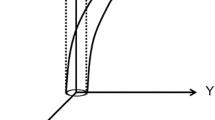Abstract
The piezoelectric potential of ZnO can be enhanced using acceptor dopants to neutralize the donor concentrations. In this study, unintentional n-type conductivity is assessed through modeling ZnO nanowires where the activation process of donors \((N_d^+)\) is given with a Fermi level \((E_F)\) close to the conduction band and followed by the introduction of an acceptor dopant \((N_a^-)\) in order to allow \(E_F\) to be within the optimum range of \(1\le E_F \le 3.2 \hbox { eV}\), which corresponds to the maximum piezoelectric potential calculated. The finite element method simulation reveals that the maximal range of ZnO piezoelectric potential can be obtained due to the intrinsic characteristics of the ZnO nanowire transformed using acceptor dopants, which implies that the limitations on the free-charge carriers (i.e. free-carrier depletion) could reduce the screening effects on the piezoelectric potential. Furthermore, the difference \({\vert }N_d^+ -N_a^- {\vert }\) is calculated to approach zero near the mid-gap and the energy band structure, which deviates from the normal flat line within the optimal range of \(1\le E_F \le 3.2 \hbox { eV}\) under the external stress imposed.





Similar content being viewed by others
References
Wang, Z.L., Song, J.H.: Piezoelectric nanogenerators based on zinc oxide nanowire arrays. Science 312, 242–246 (2006)
Wang, Z.L.: ZnO nanowire and nanoblet platform for nanotechnology. Mater. Sci. Eng. R 64, 33–71 (2009)
Hu, Y., Zhang, Y., Xu, C., Lin, L., Snyder, R.L., Wang, Z.L.: Self-powered system with wireless data transmission. Nano Lett. 11, 2572–2577 (2011)
Wang, Z.L.: Self-powered nanosensors and nanosystems. Adv. Mater. 24, 280–285 (2012)
Gao, Y., Wang, Z.L.: Equilibrium potential of free charge carriers in a bent piezoelectric semiconductive nanowire. Nano Lett. 9, 1103–1110 (2009)
Romano, G., Mantini, G., Carlo, A.D., D’Amico, A., Falconi, C., Wang, Z.L.: Piezoelectric potential in vertically aligned nanowires for high output nanogenerators. Nanotechnology 22, 465401–465406 (2011)
Kröger, F.A.: The Chemistry of Imperfect Crystals. North-Holland, Amsterdam (1974)
Look, D.C., Hemsky, J.W., Sizelove, J.R.: Residual native shallow donor in ZnO. Phys. Rev. Lett. 82, 2552–2555 (1999)
Tomlins, G.W., Routbort, J.L., Mason, T.O.: Zinc self-diffusion, electrical properties, and defect structure of undoped, single crystal zinc oxide. J. Appl. Phys. 87, 117–123 (2000)
Xu, S., Hansen, B.J., Wang, Z.L.: Piezoelectric-nanowire-enabled power source for driving wireless microelectronics. Nat. Commun. 1, 93–98 (2010)
Hu, J., Suryavanshi, A.P., Yum, K., Yu, M.F., Wang, Z.Y.: Voltage generation from individual \(\text{ BaTiO }_{3}\) nanowires under periodic tensile mechanical load. Nano Lett. 7, 2966–2969 (2007)
Cha, S.N., Kim, S.M., Kim, H.J., Ku, J.Y., Sohn, J.I., Park, Y.J., Song, B.G., Jung, M.H., Lee, E.K., Choi, B.L., Park, J.J., Wang, Z.L., Kim, J.M., Kim, K.: Porous PVDF as effective sonic wave driven nanogenerators. Nano Lett. 11, 5142–5147 (2011)
Ming-Pei, L., et al.: Piezoelectric nanogenerator using p-type ZnO nanowire arrays. Nano Lett. 9, 1223–1227 (2009)
Piezoelectric ZnO Property is Supported by the Material Library in COMSOL Multiphysics Package v. 4.2(a)
Kim, S.M., Kim, H., Nam, Y., Kim, S.: Effects of external surface charges on the enhanced piezoelectric potential of ZnO and AlN nanowires and nanotubes. AIP Adv. 2, 042174–042178 (2012)
Sohn, J.I., Cha, S.N., Song, B.G., Lee, S., Kim, S.M., Ku, J., Kim, H.J., Park, Y.J., Choi, B.L., Wang, Z.L., Kim, J.M., Kim, K.: Engineering of efficiency limiting free carriers and an interfacial energy barrier for an enhancing piezoelectric generation. Energy Environ. Sci. 6, 97–104 (2013)
Acknowledgments
This work was supported by the Computational Energy Harvesting (CEH) project in Samsung Advanced Institute of Technology. This research was supported by National Research Foundation of Korea (NRF) grants funded by the Ministry of Science, ICT & Future Planning (2009-0083540) and the Energy International Collaboration Research & Development Program of the Korea Institute of Energy Technology Evaluation and Planning funded by the Ministry of Knowledge Economy (2011-8520010050).
Author information
Authors and Affiliations
Corresponding author
Rights and permissions
About this article
Cite this article
Kim, T.Y., Kim, SW., Kim, H. et al. Effects of acceptor dopants on the enhanced piezoelectric potential of ZnO nanowires: limiting free charge-carrier density through neutralizing donors. J Comput Electron 13, 606–612 (2014). https://doi.org/10.1007/s10825-014-0577-9
Published:
Issue Date:
DOI: https://doi.org/10.1007/s10825-014-0577-9




